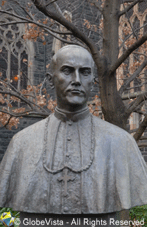Cardinal Aloysius Stepinac bust

Public Art: Cardinal Aloysius Stepinac bust
Also known as: Blessed Aloysius Stepinac or Cardinal Alojzije Stepinac memorial
Sculptor: © Mladen Mikulin
Description: A bronze bust of Cardinal Aloysius Stepinac (8th May 1898 –10 February 1960) who was a Croatian Catholic cardinal and Archbishop of Zagreb from 1937 to 1960.
Date Unveiled: The bust of Cardinal Aloysius Stepinac was formally unveiled on Saturday 10 February 2001.
Funded by: The bust was gifted to the Cathedral by the Victorian Croatian community as a reminder of the heroism and faithfulness he showed during World War II.
Location: St Patrick’s Cathedral, corner of Gisborne Street & Cathedral Place, East Melbourne, Victoria, Australia.
Inscription:
Cardinal Alojzije Stepinac
Archbishop of Zagreb
Croatia
(1898-1960)
Saint and Martyr
Things You May Not Know About Aloysius Viktor Stepinac:
Just before his eighteenth birthday he was conscripted into the Austro-Hungarian Army and fought on the Italian Front during World War I. He was captured by the Italians and held a prisoner of war for 5 months. During World War I he was awarded the Order of the Star of Karadorde, an award for heroism in the Kingdom of Yugoslavia.
Stepinac was ordained in 1930 and the next year became a parish curate in Zagreb and established the archdiocesan branch of Caritas. He became the Archbishop of Zagfreb in 1937 following the death of Archbishop Anton Bauer.
During World War II Yugoslavia was invaded by Nazi Germany and the country became the Independent State of Croatia and Stepinac became the Archbishop of the puppet state’s capital. Despite approving of the Independent State of Croatia he had nothing but contempt for the Nazis and their persecution of the Jews and Serbs.During this time he helped Jews and other to escape but continued to give communion to Ustase (Croatian Revolutionary Movement) leaders and made no public comments about their activities nor the atrocities they were inflicting. Stepinac advised his priests to admit Orthodox believers to the Catholic Church if their lives were in danger, but to give the conversion no validity, so allowing them to return to their faith when the coast was clear.
After the war Stepinac publicly condemned the new Yugoslav government and its behaviour during World War II. He was particularly scathing of the murders of non Catholics by Communist militants. His tirades led to him being found guilty of war crimes and collaboration with the fascist Ustase movement and sent to Lepoglava prison.
Thanks to the Vatican and mounting pressure from foreign and domestic sources Stephinac was eventually released and later appointed cardinal by Pope Pius XII in 1952. Stephinac served five years of his sixteen-year sentence for high treason in the Lepoglava prison. Any Catholic that was found to be on the jury during Stephinac’s trial were excommunicated by Pope Pius XII.
Aloysius Viktor Stepinac died on the 10th of February, 1960 from suspected poisoning by his communist captors.
On October 3rd, 1998, Pope John Paul II declared him a martyr and beatified him in Marija Bistrica near Zagreb.
Controversy: Despite the Vatican declaring Aloysius Viktor Stepinac a martyr and saint there are many non-Catholics who have remained unconvinced about Stepinac’s martyrdom and about his saintly qualities in general. Stephinac was unsuccessfully recommended on two occasions by two individual Croatian Jews to be added to the list of the Righteous Among the Nations.